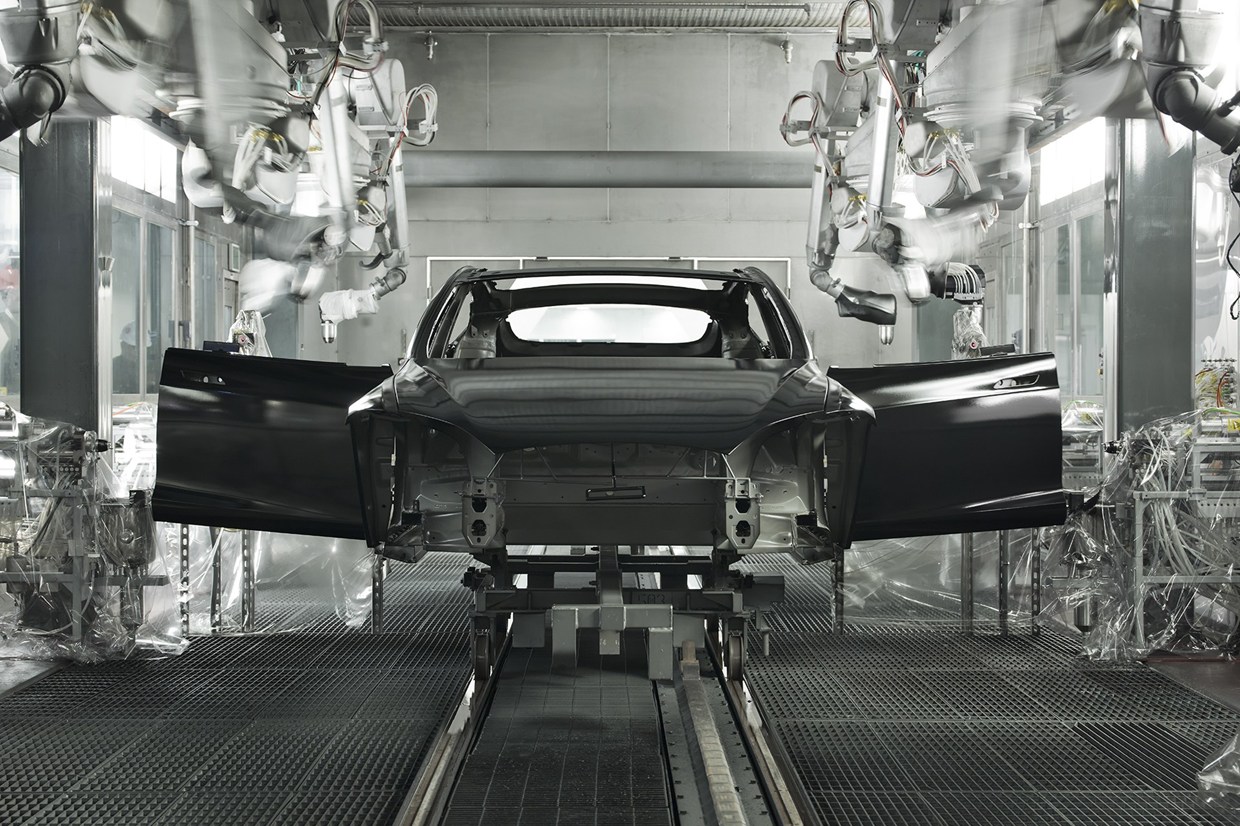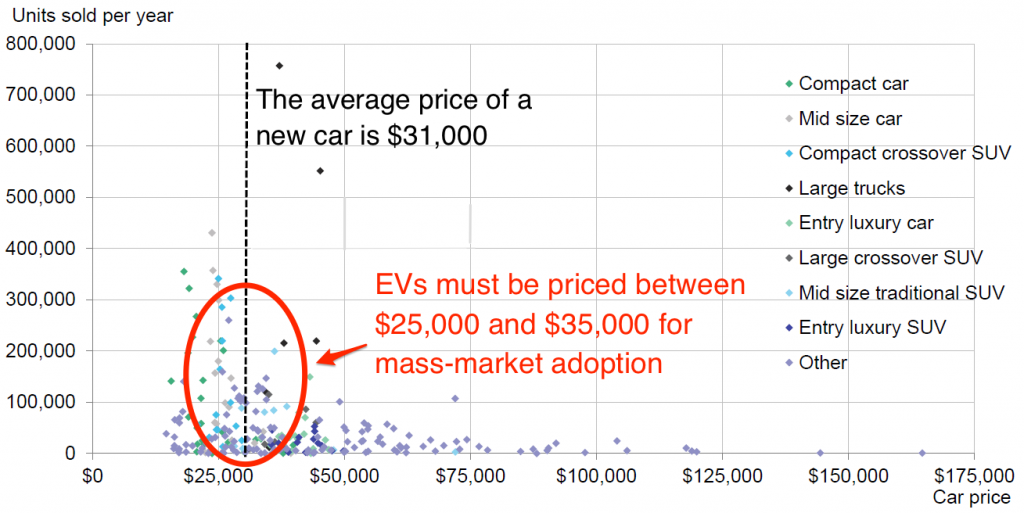News
Tesla Confirms Model 3 Price of $35,000
Tesla confirmed on February 9 that the price of the Model 3 will be $35,000 before any incentives. Spokesperson Khobi Brooklyn says it is on time and the company will have a lot more to say when the official reveal occurs in late March.

Bloomberg reported on February 9 that the starting price for the upcoming Model 3 will indeed be $35,000. That information was confirmed by Tesla spokesperson Khobi Brooklyn, who told Bloomberg, “We can confirm it’s $35,000 before incentives. We haven’t changed our minds.” More than a year ago, Elon Musk told reporters, “When I say $35,000, I’m talking about without any credits.”
EV incentives start with the $7,500 federal tax credit that anyone who buys a qualifying electric or plug-in hybrid car is eligible for. (That’s assuming the buyer actually has a federal tax liability of $7,500.) On top of the federal credit, many states offer incentives of their own. Colorado has the highest state benefit — $6,000. California, Massachusetts and Tennessee offer EV buyers $2,500. Rhode Island has just announced a $2,500 incentive, but there are only enough funds to cover less than 100 cars before the money runs out.
That means a Colorado resident could potentially park a Tesla Model 3 on the driveway for as little as $21,500. The average price of a new car today is $31,000, according to Bloomberg New Energy Finance analyst Salim Morsy. Almost all the mass market vehicles above that price are SUVs or trucks, Morsy says. The BMW 3 series sedan is the closest vehicle in size to the Model 3 that sells more than 100,000 units a year. It’s starting price is $35,000 and, of course, there are no incentives to buy one.
Before we get carried away, though, there are a few speed bumps on the road to the $35,000 Model 3. Tesla will reveal first pictures of the Model 3 next month but it’s likely that Tesla will offer Signature Series cars in its initial run for those willing to pay large deposits. After all, that’s what it did with the Model S and Model X. Those Signature Series cars were priced considerably higher than many people expected.
There is also the possibility that the Model 3 doesn’t go on sale in 2017. Morgan Stanley analyst Adam Jonas is on record as saying he doubts the Model 3 will arrive before 2018. And when it does, early cars may be loaded with expensive options the way the Model X Signature Series cars were. Jonas wouldn’t be surprised if the first cars off the assembly line were priced close to $60,000.
Keep in mind, the federal tax credit begins to phase out after a manufacturer sells 200,000 electric cars. If the Model 3 is delayed, Tesla may be close to the point where that phase out begins. As Bloomberg says, at some point, that $35,000 Model 3 is going to just be a $35,000 Model 3, subject to whatever state incentives are available.
Want to know more? You will have to wait for the March reveal. “The Model 3 is on time, and everyone is going to learn more about it at the end of March,” Khobi Brooklyn says. “That’s when we’ve committed to talking about it and giving a really great update, and that’s what we’re going to do.”
Chart: Bloomberg Business. Photo credit: Tesla Motors

Elon Musk
Starlink passes 9 million active customers just weeks after hitting 8 million
The milestone highlights the accelerating growth of Starlink, which has now been adding over 20,000 new users per day.

SpaceX’s Starlink satellite internet service has continued its rapid global expansion, surpassing 9 million active customers just weeks after crossing the 8 million mark.
The milestone highlights the accelerating growth of Starlink, which has now been adding over 20,000 new users per day.
9 million customers
In a post on X, SpaceX stated that Starlink now serves over 9 million active users across 155 countries, territories, and markets. The company reached 8 million customers in early November, meaning it added roughly 1 million subscribers in under seven weeks, or about 21,275 new users on average per day.
“Starlink is connecting more than 9M active customers with high-speed internet across 155 countries, territories, and many other markets,” Starlink wrote in a post on its official X account. SpaceX President Gwynne Shotwell also celebrated the milestone on X. “A huge thank you to all of our customers and congrats to the Starlink team for such an incredible product,” she wrote.
That growth rate reflects both rising demand for broadband in underserved regions and Starlink’s expanding satellite constellation, which now includes more than 9,000 low-Earth-orbit satellites designed to deliver high-speed, low-latency internet worldwide.
Starlink’s momentum
Starlink’s momentum has been building up. SpaceX reported 4.6 million Starlink customers in December 2024, followed by 7 million by August 2025, and 8 million customers in November. Independent data also suggests Starlink usage is rising sharply, with Cloudflare reporting that global web traffic from Starlink users more than doubled in 2025, as noted in an Insider report.
Starlink’s momentum is increasingly tied to SpaceX’s broader financial outlook. Elon Musk has said the satellite network is “by far” the company’s largest revenue driver, and reports suggest SpaceX may be positioning itself for an initial public offering as soon as next year, with valuations estimated as high as $1.5 trillion. Musk has also suggested in the past that Starlink could have its own IPO in the future.
News
NVIDIA Director of Robotics: Tesla FSD v14 is the first AI to pass the “Physical Turing Test”
After testing FSD v14, Fan stated that his experience with FSD felt magical at first, but it soon started to feel like a routine.

NVIDIA Director of Robotics Jim Fan has praised Tesla’s Full Self-Driving (Supervised) v14 as the first AI to pass what he described as a “Physical Turing Test.”
After testing FSD v14, Fan stated that his experience with FSD felt magical at first, but it soon started to feel like a routine. And just like smartphones today, removing it now would “actively hurt.”
Jim Fan’s hands-on FSD v14 impressions
Fan, a leading researcher in embodied AI who is currently solving Physical AI at NVIDIA and spearheading the company’s Project GR00T initiative, noted that he actually was late to the Tesla game. He was, however, one of the first to try out FSD v14.
“I was very late to own a Tesla but among the earliest to try out FSD v14. It’s perhaps the first time I experience an AI that passes the Physical Turing Test: after a long day at work, you press a button, lay back, and couldn’t tell if a neural net or a human drove you home,” Fan wrote in a post on X.
Fan added: “Despite knowing exactly how robot learning works, I still find it magical watching the steering wheel turn by itself. First it feels surreal, next it becomes routine. Then, like the smartphone, taking it away actively hurts. This is how humanity gets rewired and glued to god-like technologies.”
The Physical Turing Test
The original Turing Test was conceived by Alan Turing in 1950, and it was aimed at determining if a machine could exhibit behavior that is equivalent to or indistinguishable from a human. By focusing on text-based conversations, the original Turing Test set a high bar for natural language processing and machine learning.
This test has been passed by today’s large language models. However, the capability to converse in a humanlike manner is a completely different challenge from performing real-world problem-solving or physical interactions. Thus, Fan introduced the Physical Turing Test, which challenges AI systems to demonstrate intelligence through physical actions.
Based on Fan’s comments, Tesla has demonstrated these intelligent physical actions with FSD v14. Elon Musk agreed with the NVIDIA executive, stating in a post on X that with FSD v14, “you can sense the sentience maturing.” Musk also praised Tesla AI, calling it the best “real-world AI” today.
News
Tesla AI team burns the Christmas midnight oil by releasing FSD v14.2.2.1
The update was released just a day after FSD v14.2.2 started rolling out to customers.

Tesla is burning the midnight oil this Christmas, with the Tesla AI team quietly rolling out Full Self-Driving (Supervised) v14.2.2.1 just a day after FSD v14.2.2 started rolling out to customers.
Tesla owner shares insights on FSD v14.2.2.1
Longtime Tesla owner and FSD tester @BLKMDL3 shared some insights following several drives with FSD v14.2.2.1 in rainy Los Angeles conditions with standing water and faded lane lines. He reported zero steering hesitation or stutter, confident lane changes, and maneuvers executed with precision that evoked the performance of Tesla’s driverless Robotaxis in Austin.
Parking performance impressed, with most spots nailed perfectly, including tight, sharp turns, in single attempts without shaky steering. One minor offset happened only due to another vehicle that was parked over the line, which FSD accommodated by a few extra inches. In rain that typically erases road markings, FSD visualized lanes and turn lines better than humans, positioning itself flawlessly when entering new streets as well.
“Took it up a dark, wet, and twisty canyon road up and down the hill tonight and it went very well as to be expected. Stayed centered in the lane, kept speed well and gives a confidence inspiring steering feel where it handles these curvy roads better than the majority of human drivers,” the Tesla owner wrote in a post on X.
Tesla’s FSD v14.2.2 update
Just a day before FSD v14.2.2.1’s release, Tesla rolled out FSD v14.2.2, which was focused on smoother real-world performance, better obstacle awareness, and precise end-of-trip routing. According to the update’s release notes, FSD v14.2.2 upgrades the vision encoder neural network with higher resolution features, enhancing detection of emergency vehicles, road obstacles, and human gestures.
New Arrival Options also allowed users to select preferred drop-off styles, such as Parking Lot, Street, Driveway, Parking Garage, or Curbside, with the navigation pin automatically adjusting to the ideal spot. Other refinements include pulling over for emergency vehicles, real-time vision-based detours for blocked roads, improved gate and debris handling, and Speed Profiles for customized driving styles.










